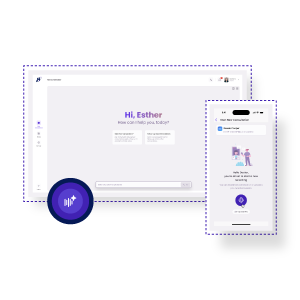Healthcare must never be hindered by the language. However, thousands of NHS patients do not use English as their native language, miscommunication occurs daily, and in some situations, with severe results.
To meet growing demand, NHS trusts are starting to adopt faster solutions, such as AI interpreters, in their workflows. They are also quick, on-demand, and economically friendly.
The big question is, however, whether such tools can be trusted, particularly at their most crucial stage. Let’s break down where AI interpreters in NHS settings can genuinely help—and where the risks may rise if they’re misused.
What Is an Interpreter in Healthcare?
The role of an accurate interpreter in healthcare is the person who facilitates communication between the patients and healthcare providers in case the parties do not speak the same language. Their task is not to translate the words but to ensure that both parties are completely aware of one another.
The interpreters can be deployed in cases of:
- Medical examinations and diagnosis
- Surgery or procedure consent
- Mental assessments
- End-of-life discussions
- Protective or criminal dialogues
Translation and Interpreting The NHS has interpreting and translation services that are face-to-face, via the telephone, and video. But with rising demand, tech-based solutions like AI interpreters in NHS clinics are being explored to fill the gaps—especially for administrative conversations or urgent access.
The Rise of AI Medical Interpreter NHS Tools
The need to have multilingual support in the NHS hospitals has been at an all-time high. The NHS staff members deal with more than 150 languages when communicating with patients daily. That’s where AI medical interpreter NHS tools have gained popularity. A systematic review of AI translation apps’ patient safety in clinical settings examined accuracy, usability, and satisfaction.
The instruments allow the patient to talk into a phone or gadget, after which the translation is completed immediately- this can be in seconds. It is convenient, and it can be expanded or reduced easily.
Why Clinicians are Using Them?
- Fewer delays during admin and check-ins
- Support for hard-to-source languages
- Instant availability when human interpreters aren’t around
But when used without limits, they introduce risk. Not every conversation in healthcare can—or should—be translated by a machine.
When Can AI Interpreters in the NHS Help?
There are clear situations where AI interpreters in NHS services do make sense:
Reception and Admin Tasks
For front-desk staff, AI tools are useful for:
- Asking patients for ID or NHS numbers
- Confirming appointments or check-in times
- Giving directions to wards or clinics
These are routine, low-risk tasks where clarity and speed matter more than nuance.
Night Shifts or Emergency Overflow
When a trained interpreter isn’t available—especially during nights or weekends—AI translation can fill in as a temporary solution for basic communication.
This is particularly helpful in busy A&E units where NHS interpreting and translation services can’t always respond in time.
When AI Translation Risks Patient Safety?
Fast translations aren’t always safe translations. Here’s where caution is key.
Informed Consent
Patients need to fully understand risks and benefits before signing off on treatment or surgery. AI tools might mistranslate medical terms or downplay risk language.
That’s not just bad practice—it can lead to legal issues.
Delivering Diagnoses
Telling someone they have cancer, diabetes, or need surgery? That’s a moment that requires empathy, clarity, and two-way trust. A generic app won’t capture emotional tone or body language.
Mental Health Consultations
When discussing trauma, depression, or anxiety, cultural context and language nuance matter deeply. Misinterpretations could lead to the wrong diagnosis—or missed danger signs.
In these situations, relying on top AI transcription apps, patient safety becomes a real concern.
Understanding the Accessible Information Standard (AIS) NHS
The Accessible Information Standard (AIS) NHS is a national requirement. It says every NHS provider must make sure patients with communication needs—including limited English—get support they understand.
That means tools must be:
- Accurate and reliable
- Culturally appropriate
- Flexible to a range of conditions
So while AI interpreters in NHS workflows can help with admin tasks, they don’t fully meet AIS standards when it comes to medical decision-making.
That’s why most trusts still rely on NHS interpreting and translation services for anything clinical.
How HealthOrbit AI Supports Safe, Smart Communication?
At HealthOrbit AI, we build solutions that enhance workflow without cutting corners on care quality.
- Built-in multilingual support for admin tasks
- Structured SOAP Notes with voice documentation
- Compliant, HIPAA-compliant architecture
- Fully secure and scalable for NHS needs
Whether you’re confirming an appointment or prepping a discharge summary, our secure AI assistant is built to ensure the right message gets through.
Final Thoughts
There’s no doubt that AI interpreters in NHS settings have value. Used well, they help staff manage more patients, reduce waiting times, and break down language barriers. But they aren’t a cure-all. And they should never be used in place of trained human interpreters during high-risk conversations.
With tools like HealthOrbit AI, you don’t have to choose between efficiency and safety. Contact us today to get more information.
FAQs
Can AI interpreters replace NHS translators?
No. They’re useful in admin situations, but medical conversations should still be handled by trained interpreters.
Are AI tools safe for giving medical instructions?
Only in basic cases. For anything involving diagnosis, consent, or emotional care, human interpretation is strongly advised.
Does HealthOrbit AI support the AIS standard?
Yes—for admin and general communication tasks. For complex clinical conversations, we recommend using alongside NHS translation services.
Where are AI interpreters most helpful in NHS clinics?
Reception desks, appointment bookings, and general info sharing. They reduce pressure on admin teams.
Is HealthOrbit AI suitable for UK practices?
Absolutely. Our platform is built for UK clinical teams, with NHS-compatible workflows and top-tier data protection.




